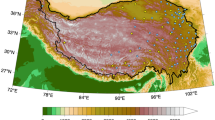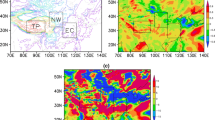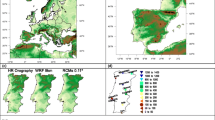Abstract
Lake Tanganyika is the second largest freshwater lake in the world by volume and is of prime importance for the regional economy in East Africa. Although the lake is recognized as a key component of the regional climate system, little is known about atmospheric dynamics in its surroundings. To understand this role, we analyze winds around Lake Tanganyika as modeled by a high resolution (7 km) regional climate model (Consortium for Small-scale Modeling in Climate Mode) over the period 1999–2008. Modeled surface wind speed and direction are in very good agreement with high resolution (12.5 km) Quick Scatterometer (QuikSCAT) satellite wind observations during the dry season. Comparison of a control run with a model simulation where all lake pixels are replaced by representative land pixels indicates that mean surface wind speed over Lake Tanganyika almost doubles due to lake presence. Furthermore, a region of higher surface wind speed in the central part of the lake is identified and confirmed by QuikSCAT observations. A combination of wind channeling along valley mountains and wind confluence on the upwind side of the lake is responsible for this speed-up. The lower wind speeds in the rest of the lake result from blocked conditions due to more pronounced orography. Finally, the model captures a zone of higher wind speed at around 2 km height, associated with the low-level Somali jet. These results demonstrate that high resolution climate modeling allows a detailed understanding of wind dynamics in the vicinity of Lake Tanganyika.












Similar content being viewed by others
References
Akkermans T, Lauwaet D, Demuzere M, Vogel G, Nouvellon Y, Ardö J, Caquet B, De Grandcourt A, Merbold L, Kutsch W, Van Lipzig N (2012) Validation and comparison of two soil-vegetation-atmosphere transfer models for tropical Africa. J Geophys Res 117(G02):013. doi:10.1029/2011JG001802
Akkermans T, Rompaey AV, Lipzig NV (2013) Quantifying successional land cover after clearing of tropical rainforest along forest frontiers in the Congo Basin. Phys Geogr 34(6):417–440. doi:10.1080/02723646.2013.855698
Akkermans T, Thiery W, Van Lipzig NPM (2014) The regional climate impact of a realistic future deforestation scenario in the Congo Basin. J Clim 27(7):2714–2734. doi:10.1175/JCLI-D-13-00361.1
Bentamy A, Grodsky SA, Carton JA, Croiz-Fillon D, Chapron B (2012) Matching ASCAT and QuikSCAT winds. J Geophys Res Oceans. doi:10.1029/2011JC007479
Chakraborty A, Nanjundiah RS, Srinivasan J (2009) Impact of african orography and the indian summer monsoon on the low-level somali jet. Int J Climatol 29(7):983–992. doi:10.1002/joc.1720
Coulter GW (1991) Lake Tanganyika and its life. Oxford University Press, London
Davarzani H, Smits K, Tolene RM, Illangasekare T (2014) Study of the effect of wind speed on evaporation from soil through integrated modeling of the atmospheric boundary layer and shallow subsurface. Water Resour Res 50:661–680. doi:10.1002/2013WR013952
Davin EL, Seneviratne SI (2012) Role of land surface processes and diffuse/direct radiation partitioning in simulating the European climate. Biogeosciences 9(5):1695–1707. doi:10.5194/bg-9-1695-2012
Fore A, Stiles B, Chau A, Williams B, Dunbar R, Rodriguez E (2014) Point-wise wind retrieval and ambiguity removal improvements for the QuikSCAT climatological data set. IEEE Trans Geosci Remote Sens 52(1):51–59. doi:10.1109/TGRS.2012.2235843
Hastings DA, Dunbar PK, Elphingstone GM, Bootz M, Murakami H, Maruyama H, Masaharu H, Holland P, Payne J, Bryant NA, Logan TL, Muller JP, Schreier G, MacDonald JS (1999) The global land one-kilometer base elevation (GLOBE) digital elevation model, version 1.0. http://www.ngdc.noaa.gov/mgg/topo/globe.html
Holton JR (2004) An introduction to dynamic meteorology, 4th edn. Academic Press, London
Kraemer BM, Hook S, Huttula T, Kotilainen P, OReilly CM, Peltonen A, Plisnier PD, Sarvala J, Tamatamah R, Vadeboncoeur Y, Wehrli B, McIntyre PB (2015) Century-long warming trends in the upper water column of Lake Tanganyika. PLoS One 10(7):e0132,490. doi:10.1371/journal.pone.0132490
Mironov DV, Heise E, Kourzeneva E, Ritter B, Schneider N, Terzhevik A (2010) Implementation of the lake parameterisation scheme Flake into the numerical weather prediction model COSMO. Boreal Environ Res 15:218–230
Naithani J, Deleersnijder E, Plisnier PD (2002) Origin of intraseasonal variability in Lake Tanganyika. Geophys Res Lett 29(23):2093. doi:10.1029/2002GL015843
Naithani J, Deleersnijder E, Plisnier P (2003) Analysis of wind-induced thermocline oscillations of Lake Tanganyika. Environ Fluid Mech 3:23–39
Nghiem SV, Leshkevich GA, Stiles BW (2004) Wind fields over the Great Lakes measured by the SeaWinds Scatterometer on the QuikSCAT Satellite. J Great Lakes Res 30(1):148–165. doi:10.1016/S0380-1330(04)70337-8
Niang I, Ruppel O, Abdrabo M, Essel A, Lennard C, Padgham J, Urquhart P (2014) Africa. In: Barros V, Field C, Dokken D, Mastrandrea M, Mach K, Bilir T, Chatterjee M, Ebi K, Estrada Y, Genova R, Girma B, Kissel E, Levy A, MacCracken S, Mastrandrea P, White L (eds) Climate change 2014: impacts, adaptation, and vulnerability. Part B: Regional aspects. Contribution of working group II to the fifth assessment report of the intergovernmental panel on climate change. Cambridge University Press, Cambridge, pp 1199–1265
Nicholson S (1996) A review of climate dynamics and climate variability in Eastern Africa. In: Johnson T, Odada E (eds) The limnology, climatology and paleoclimatology of the East African lakes. Gordon and Breach, Amsterdam, pp 25–56
Plisnier P, Chitamwebwa D, Mwape L, Tshibangu K, Langenberg V, Coenen E (1999) Limnological annual cycle inferred from physical-chemical fluctuations at three stations of Lake Tanganyika. Hydrobiologia 407:45–58
Reinecke PA, Durran DR (2008) Estimating topographic blocking using a Froude number when the static stability is nonuniform. J Atmos Sci 65:1035–1048
Savijärvi H (1997) Diurnal winds around Lake Tanganyika. Q J R Meteorol Soc 123:901–918
Savijärvi H, Järvenoja S (2000) Aspects of the fine-scale climatology over Lake Tanganyika as resolved by a mesoscale model. Meteorol Atmos Phys 73(1–2):77–88
Thiery W, Martynov A, Darchambeau F, Descy JP, Plisnier PD, Sushama L, van Lipzig NPM (2014) Understanding the performance of the FLake model over two African Great Lakes. Geosci Model Dev 7(1):317–337. doi:10.5194/gmd-7-317-2014
Thiery W, Stepanenko VM, Fang X, Jöhnk KD, Li Z, Martynov A, Perroud M, Subin ZM, Darchambeau F, Mironov D (2014b) LakeMIP Kivu: Evaluating the representation of a large, deep tropical lake by a set of 1-dimensional lake models. Tellus A 66(21):390. doi:10.3402/tellusa.v66.21390
Thiery W, Davin E, Panitz HJ, Demuzere M, Lhermitte S, van Lipzig N (2015) The impact of the African Great Lakes on the regional climate. J Clim 28(10):4061–4085. doi:10.1175/JCLI-D-14-00565.1
Tierney J, Mayes M, Meyer N (2010) Late-twentieth-century warming in Lake Tanganyika unprecedented since AD 500. Nat Geosci 3:422–425. doi:10.1038/NGEO865
van Lipzig N, Marshall G, Orr A, King J (2008) The relationship between the southern hemisphere annular mode and Antarctic Peninsula summer temperatures: Analysis of a high-resolution model climatology. J Clim 21(8):1649–1668. doi:10.1175/2007JCLI1695.1
Verburg P, Antenucci JP (2010) Persistent unstable atmospheric boundary layer enhances sensible and latent heat loss in a tropical great lake: Lake Tanganyika. J Geophys Res 115(D11):109. doi:10.1029/2009JD012839
Verburg P, Hecky R (2003) Wind patterns, evaporation, and related physical variables in Lake Tanganyika, East Africa. J Great Lakes Res 29:48–61
Verburg P, Hecky R (2009) The physics of the warming of Lake Tanganyika by climate change. Limnol Oceanogr 54:2418–2430
Verburg P, Antenucci JP, Hecky RE (2011) Differential cooling drives large-scale convective circulation in Lake Tanganyika. Limnol Oceanogr 56(3):910–926. doi:10.4319/lo.2011.56.3.0910
Wallace JM, Hobbs PV (2006) Atmospheric Science. Elsevier, Philadelphia
Acknowledgments
We would like to thank Y. Cornet and N. Poncelet for the interesting discussion concerning lake surface water temperature over the African Great Lakes. We also thank I. Gorodetskaya for her input during group discussion. We sincerely thank the editor and two reviewers for their constructive remarks which helped to improve the manuscript. D. Docquier is funded by the Belgian Science Policy Office (BELSPO) through the research project EAGLES. W. Thiery and S. Lhermitte are funded by the Research Foundation Flanders (FWO). The computational resources and services used in this work were provided by the Flemish Supercomputer Center (VSC), funded by the Hercules Foundation and the Flemish Government—department EWI.
Author information
Authors and Affiliations
Corresponding author
Rights and permissions
About this article
Cite this article
Docquier, D., Thiery, W., Lhermitte, S. et al. Multi-year wind dynamics around Lake Tanganyika. Clim Dyn 47, 3191–3202 (2016). https://doi.org/10.1007/s00382-016-3020-z
Received:
Accepted:
Published:
Issue Date:
DOI: https://doi.org/10.1007/s00382-016-3020-z




